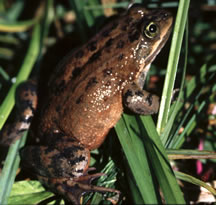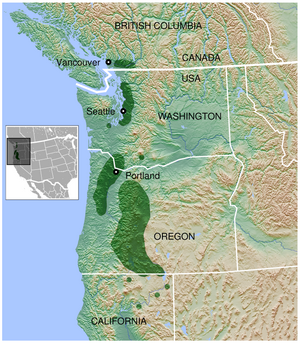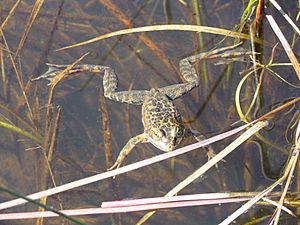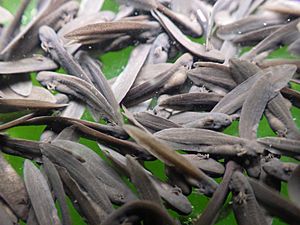Oregon spotted frog facts for kids
Quick facts for kids Oregon spotted frog |
|
|---|---|
 |
|
| Conservation status | |
| Scientific classification | |
 |
|
| Oregon Spotted Frog range |
The Oregon spotted frog (Rana pretiosa) is a special type of frog found in the Pacific Northwest. Its name, pretiosa, means "precious frog," which fits because it's quite rare! This medium-sized frog lives mostly in water. It used to be found all over the Puget Trough/Willamette Valley and the Cascade Mountains in Washington and Oregon. Today, it's considered a vulnerable animal globally, meaning it needs our help to survive.
Contents
Where They Live
Oregon spotted frogs live in parts of southwestern British Columbia, Canada. They also live south through the Puget/Willamette Valley and the Columbia River gorge in south-central Washington. You can find them in the Cascade Range in Oregon, reaching as far south as the Klamath Valley.
These frogs used to live in California but are now gone from there. They have also disappeared from many areas in western Oregon and Washington. They can live in places from about 65 feet (20 meters) to over 5,000 feet (1,570 meters) above sea level.
In Oregon, you can currently find them in Deschutes, Lane, and Klamath counties. In Washington, they are found in Thurston County.
What They Look Like
Adult Oregon spotted frogs are usually about 1.75 to 4 inches (4.4 to 10 cm) long from their snout to their tail end. Like most amphibians, female frogs are often bigger than males. This helps them lay more eggs.
Their color changes as they grow. Young tadpoles have brown backs and tails with no dark spots. Their bellies are a creamy white color. Young frogs are usually brown, but some can be olive green. Adult Oregon spotted frogs can be brown or reddish-brown. They often become more red as they get older.
Both young and adult frogs have black spots with light centers on their heads and backs. These spots get bigger and darker with age. Older frogs often turn a brick red color on most of their backs. Their entire belly, up to their chest, can also become red.
Young frogs have white or cream-colored undersides with some reddish color on their legs and belly. Adults show a bright orange-red color on their underlegs and red on their bellies. The folds of skin on their backs are usually lighter, from tan to orange.
The Oregon spotted frog has short hind legs compared to its body. Their groin area is usually gray, sometimes with faint gray spots and red-orange flecks. Their back feet are fully webbed, and the webbing goes all the way to the end of their longest toe. Their eyes point upwards and are mostly visible when you look at them from above.
Where Frogs Live
The Oregon spotted frog loves water and rarely leaves it. They prefer still water bodies like wetlands, lakes, and slow-moving streams. These places need to have shallow areas with lots of plants growing in or on the water.
They use mats of water plants to warm themselves in the sun. They also dive under these plants to hide from danger. These habitats often have a thin layer of warm water, which the frogs seem to really like.
What Frogs Eat
Adult Oregon spotted frogs eat different kinds of live animals. They mostly eat insects. Young Oregon spotted frog tadpoles eat algae, rotting plants, and other tiny bits of decaying material.
Frog Reproduction
Oregon spotted frogs only reproduce in water. Their breeding season is short, lasting less than four weeks in late winter. Male frogs make quiet calls day and night near their traditional egg-laying spots. These are places where females lay their eggs in shared piles.
Egg-laying starts when the water temperature reaches about 46°F (8°C). The exact timing changes depending on the location. It can be from late February to early March in low-lying areas. In mountain areas of Oregon, it might be from late May to late June.
They breed in warm, shallow water, often just 2 to 12 inches (5 to 30 cm) deep. Grasses, sedges, and rushes are usually growing in these areas. Female frogs are thought to breed every year and usually lay one egg mass each year.
While some egg masses are laid alone, most are laid in shared spots. These shared egg clusters often have between 10 and 75 individual egg masses. In British Columbia, one egg mass was found to have an average of 643 eggs! They lay their eggs in open, shallow water that the sun can warm easily. This helps the eggs hatch faster. However, it also makes the eggs more vulnerable to drying out or freezing.
Frog Life Cycle
Once fertilized, Oregon spotted frog eggs quickly start to develop into larvae. The larvae then hatch into tadpoles in about 18 to 30 days. They don't change into juvenile frogs until 110 to 130 days after hatching in British Columbia. In Oregon, this change might happen as quickly as 95 days.
After changing from a tadpole into a young frog, the juveniles might stay around the breeding ponds for a while. We don't know much about where they go next. Once they become adult frogs, males in British Columbia can start reproducing in their second year. Females are thought to be ready to reproduce in their second or third year. In central Washington, most males can reproduce by the end of their first year. Females are ready by the middle of their second year.
We don't know much about how long Oregon spotted frogs live. However, it's thought they have a relatively short life, usually between two and five years.
Related Frogs
The Columbia spotted frog (Rana luteiventris) was once thought to be a subspecies of the Oregon spotted frog. However, scientists later decided it was a completely separate species.
Protecting the Oregon Spotted Frog
The Oregon spotted frog is listed as vulnerable on the IUCN Red List, which is an international list of threatened species. In the United States, it was listed as threatened under the Endangered Species Act (ESA) in 2014. In Canada, it is listed as endangered under the Species at Risk Act.
Their numbers have dropped because of several reasons. One big reason is the presence of the bullfrog, which was brought into their areas. Another reason is the loss and damage of their breeding habitats. This can happen because of things like building dams, changing water flow, or taking too much water for cities and farms. Too much livestock grazing and other human activities can also harm their shallow water homes.
Recovery Programs
Several groups are working to help the Oregon spotted frog recover. These include the Vancouver Aquarium, the Greater Vancouver Zoo, the Woodland Park Zoo, the Washington State Department of Fish and Wildlife, Northwest Trek Wildlife Park, and Evergreen State College.
School groups are also helping to improve the frog's habitat. They do this by managing invasive plants like canarygrass and controlling bullfrogs. Teaching naturalists about the frogs has also helped find new places where they live.
- Columbia spotted frog (Rana luteiventris)
See also
 In Spanish: Rana pretiosa para niños
In Spanish: Rana pretiosa para niños





